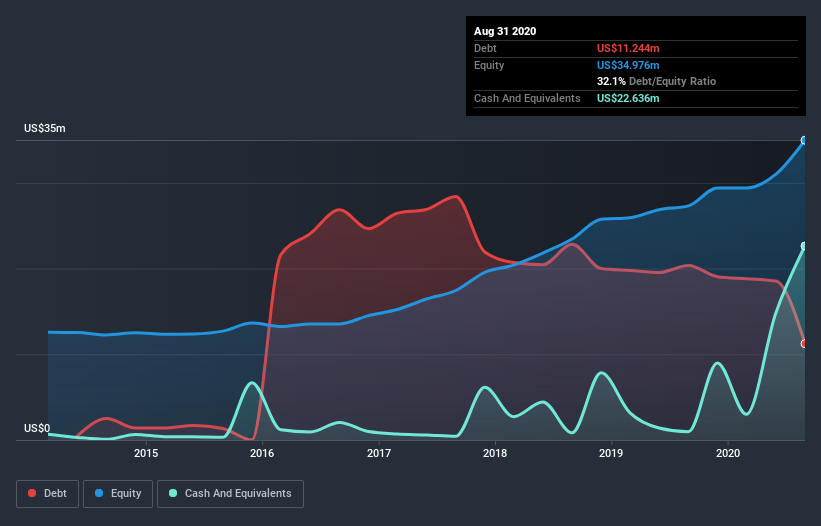Is Educational Development (NASDAQ:EDUC) Using Too Much Debt?
Legendary fund manager Li Lu (who Charlie Munger backed) once said, 'The biggest investment risk is not the volatility of prices, but whether you will suffer a permanent loss of capital.' When we think about how risky a company is, we always like to look at its use of debt, since debt overload can lead to ruin. We can see that Educational Development Corporation (NASDAQ:EDUC) does use debt in its business. But the real question is whether this debt is making the company risky.
Why Does Debt Bring Risk?
Debt and other liabilities become risky for a business when it cannot easily fulfill those obligations, either with free cash flow or by raising capital at an attractive price. Ultimately, if the company can't fulfill its legal obligations to repay debt, shareholders could walk away with nothing. However, a more usual (but still expensive) situation is where a company must dilute shareholders at a cheap share price simply to get debt under control. Of course, plenty of companies use debt to fund growth, without any negative consequences. When we think about a company's use of debt, we first look at cash and debt together.
View our latest analysis for Educational Development
How Much Debt Does Educational Development Carry?
The image below, which you can click on for greater detail, shows that Educational Development had debt of US$11.2m at the end of August 2020, a reduction from US$20.4m over a year. However, its balance sheet shows it holds US$22.6m in cash, so it actually has US$11.4m net cash.
A Look At Educational Development's Liabilities
Zooming in on the latest balance sheet data, we can see that Educational Development had liabilities of US$37.9m due within 12 months and liabilities of US$11.7m due beyond that. On the other hand, it had cash of US$22.6m and US$3.27m worth of receivables due within a year. So its liabilities outweigh the sum of its cash and (near-term) receivables by US$23.7m.
Given Educational Development has a market capitalization of US$138.3m, it's hard to believe these liabilities pose much threat. Having said that, it's clear that we should continue to monitor its balance sheet, lest it change for the worse. While it does have liabilities worth noting, Educational Development also has more cash than debt, so we're pretty confident it can manage its debt safely.
In addition to that, we're happy to report that Educational Development has boosted its EBIT by 67%, thus reducing the spectre of future debt repayments. There's no doubt that we learn most about debt from the balance sheet. But it is Educational Development's earnings that will influence how the balance sheet holds up in the future. So if you're keen to discover more about its earnings, it might be worth checking out this graph of its long term earnings trend.
Finally, a company can only pay off debt with cold hard cash, not accounting profits. While Educational Development has net cash on its balance sheet, it's still worth taking a look at its ability to convert earnings before interest and tax (EBIT) to free cash flow, to help us understand how quickly it is building (or eroding) that cash balance. Happily for any shareholders, Educational Development actually produced more free cash flow than EBIT over the last three years. There's nothing better than incoming cash when it comes to staying in your lenders' good graces.
Summing up
Although Educational Development's balance sheet isn't particularly strong, due to the total liabilities, it is clearly positive to see that it has net cash of US$11.4m. And it impressed us with free cash flow of US$33m, being 162% of its EBIT. So we don't think Educational Development's use of debt is risky. When analysing debt levels, the balance sheet is the obvious place to start. However, not all investment risk resides within the balance sheet - far from it. Case in point: We've spotted 1 warning sign for Educational Development you should be aware of.
At the end of the day, it's often better to focus on companies that are free from net debt. You can access our special list of such companies (all with a track record of profit growth). It's free.
This article by Simply Wall St is general in nature. It does not constitute a recommendation to buy or sell any stock, and does not take account of your objectives, or your financial situation. We aim to bring you long-term focused analysis driven by fundamental data. Note that our analysis may not factor in the latest price-sensitive company announcements or qualitative material. Simply Wall St has no position in any stocks mentioned.
Have feedback on this article? Concerned about the content? Get in touch with us directly. Alternatively, email editorial-team (at) simplywallst.com.

